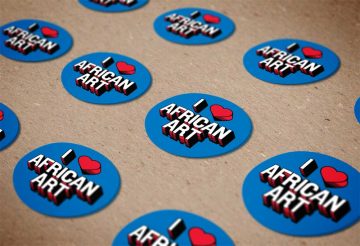International Traveling Exhibition Displays 225 Objects of Utility, Empowerment and Spiritual Potency
Exhibition Was Rescheduled to April 17 Due to Government Shutdown
“Striking Iron: The Art of African Blacksmiths” will open at the Smithsonian’s National Museum of African Art April, 17. The exhibition, organized by the Fowler Museum at UCLA, reveals the histories of invention and technical sophistication that led African blacksmiths to transform one of Earth’s most fundamental natural resources into objects of life-changing utility, empowerment, prestige, artistry and spiritual potency. The exhibition features more than 225 works of art, including blades and currencies in myriad shapes and sizes, wood sculptures studded with iron, musical instruments and elaborate body adornments. ”Striking Iron” will close Oct. 20 and then travel to the Musée du quai Branly-Jacques Chirac in Paris (November 2019–March 2020).
The Iron Age revolutionized Africa and forever altered human civilization practically and symbolically. Technologies of iron smelting and forging, which likely began on the African continent around 2,500 years ago, were ardently sought and guarded. Their control could promote a king’s ambition, enhance a soldier’s fortune and secure a community’s well-being. Iron tools and weapons enabled Africans to forage, hunt and till the soil, assuring prosperity and protection.
The majority of objects in “Striking Iron” date from the 19th and 20th centuries and are drawn from the Fowler’s extensive collection or borrowed from 49 U.S. and European public and private collections. Works were selected that highlight blacksmiths’ virtuosity and introduce the ways forged iron objects harness the powers of the natural and spiritual worlds; ensure prestige, status and endurance; assist with life’s challenges and transitions; and enhance the efficacies of sacred acts such as ancestor veneration, healing, fertility and prophecy. Blacksmiths’ work and participation in community life continues to be indispensable today.
“We are excited to share ‘Striking Iron’ with our visitors at the National Museum of African Art,” said Gus Casely-Hayford, director of the National Museum of African Art. “Nowhere else in the world are there more diverse and accomplished forged-iron forms than in Africa, and ‘Striking Iron’ is the most comprehensive treatment of the blacksmith’s arts of Africa to date. The exhibition, backed by outstanding scholarship, is a tour de force in presenting artworks of great aesthetic beauty and exceptional technical expertise. This is a one-of-a-kind visual experience that will appeal to audiences of all ages and interests.”
“There are many stories to tell in ‘Striking Iron,’ and each one brings respect and admiration to the time-honored and even divine work of smelting and forging iron in Africa,” said Marla C. Berns, the Shirley & Ralph Shapiro Director at the Fowler Museum and exhibition co-curator. “The ambition of ‘Striking Iron’ lies in its scope—with diverse works made by over 100 ethnic groups living in 19 countries, mostly south of the Sahara—and in showing how, through their mastery, blacksmiths have invested great cultural importance and meaning in the objects they make.”
The exhibition is organized around eight thematic sections and features a range of videos, including seven short object-specific chats by Tom Joyce, who is the lead exhibition curator, an internationally acclaimed sculptor and a MacArthur Fellow trained in the art of forging iron. The exhibition’s thematic approach offers a layered and comparative view of forms, materials and uses of iron.
Educational Programs
Public programs will accompany the exhibition to engage the museum’s diverse audiences from K–12 to adult.
Gallery Tour
Joyce and Christine Mullen Kreamer, deputy director and chief curator at the National Museum of African Art, will conduct a “first look” walk-through tour of exhibition highlights. The tour is free and open to the public Sunday, March 3, at 2 p.m. Participants should meet at the museum’s visitor desk on the Pavilion level at 2 p.m.
Publication
An illustrated, multi-author scholarly volume published by the Fowler Museum accompanies the exhibition.
Credit
“Striking Iron: The Art of African Blacksmiths” is organized by the Fowler Museum at UCLA. The exhibition is based on decades of research by its curatorial team, which is led by Joyce and includes Allen F. Roberts, professor of UCLA’s Department of World Arts and Cultures/Dance; Berns; William J. Dewey, director of the African Studies Program and associate professor of African art history at Pennsylvania State University; and Henry J. Drewal, the Evjue-Bascom Professor of Art History and Afro-American Studies at the University of Wisconsin–Madison. Seven additional advising scholars brought their specific areas of expertise to the project Kreamer is overseeing the exhibition at the museum.
The exhibition is made possible by major funding from the National Endowment for the Humanities and the National Endowment for the Arts. Support is also provided by the Martha and Avrum Bluming Exhibition Fund.
About the National Museum of African Art
The National Museum of African Art is the only museum in the world dedicated solely to the collection, conservation, study and exhibition of Africa’s arts across time and media. The museum’s collection of over 12,000 artworks represents the diversity of the African continent and includes a variety of media—from sculpture and painting, to photography, pottery, jewelry, textile, video and sound art. The museum is open daily from 10 a.m. to 5:30 p.m. (closed Dec. 25). Admission is free. The museum is located at 950 Independence Ave. S.W., near the Smithsonian Metrorail station on the Blue, Orange and Silver lines. For more information, call (202) 633-4600 or visit the National Museum of African Art’s website. For general Smithsonian information, call (202) 633-1000. Follow the museum on Twitter, YouTube, Instagram and Facebook and join in the discussion about the exhibition on social media using #StrikingIron.
